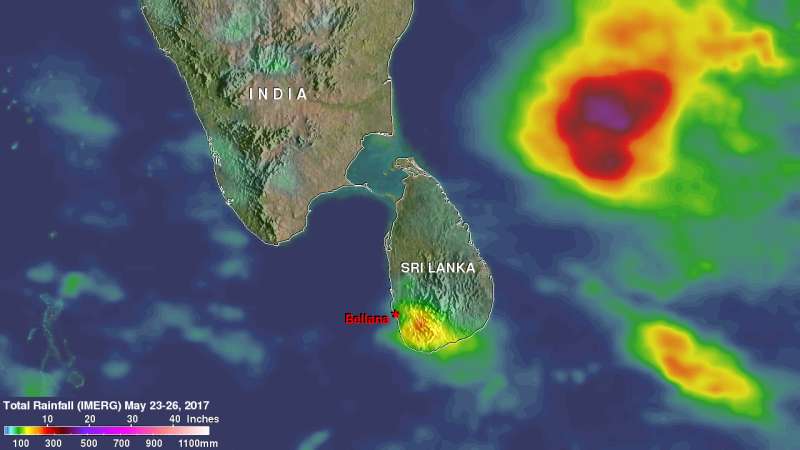NASA observes heavy monsoon rainfall in Sri Lanka

NASA's Global Precipitation Measurement mission or GPM satellite constellation provided rainfall data after the monsoon generated large amounts of precipitation in Sri Lanka that caused landslides over the week of May 22. The monsoon continued to affect the island on May 30 when a weather advisory was issued for strong winds.
More than 90 people have been reported killed and over 100 missing due to a landslide in the village of Bellana, in the Kalutara district of Sri Lanka.
In an analysis of rainfall accumulation using NASA's Integrated Multi-satellitE Retrievals for GPM (IMERG) data, heavy rainfall was measured over the southwestern Bay of Bengal over the period from May 23 to early May 26, 2017. The maximum IMERG rainfall accumulation estimates over the Bay of Bengal to the northeast of Sri Lanka estimated over 434 mm (17 inches) or rain had fallen. GPM is a joint mission between NASA and the Japanese space agency JAXA
The village of Bellana, where the landslide occurred is located on the southwestern side of Sri Lanka. The heaviest rainfall over Sri Lanka for this period appeared on the southern side of the Island nation to the east of Bellana.
On May 30 at 12:30 p.m. local time in Sri Lanka, the Early Warning Centre of the Department of Meteorology in Sri Lanka issued a Weather Advisory for strong winds and rough sea areas valid for next 36 hours.
The advisory noted that also Tropical Cyclone Mora made landfall in Bangladesh, windy conditions are expected to continue around and over the island of Sri Lanka today. Strong winds can be expected up to 80 kph, especially over the western slope of the Central hills. The advisory noted "The sea area off the coast extending from Puttalam to Trincomalee via Kankasanturai and sea area off the coast extending from Galleto Batticaloavia Hambantota can be very rough at times as the wind speed can increase up to 80 kph at times." For additional updates, visit: http://www.meteo.gov.lk
Provided by NASA's Goddard Space Flight Center


















